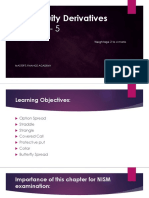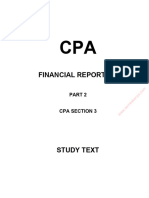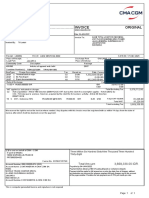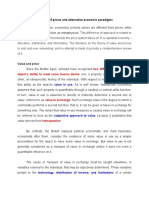Calculation of Beta
Calculation of Beta
Uploaded by
armailgmCopyright:
Available Formats
Calculation of Beta
Calculation of Beta
Uploaded by
armailgmOriginal Description:
Original Title
Copyright
Available Formats
Share this document
Did you find this document useful?
Is this content inappropriate?
Copyright:
Available Formats
Calculation of Beta
Calculation of Beta
Uploaded by
armailgmCopyright:
Available Formats
Gold is a safe bet because during uncertain times it, acts as an hedge against inflation.
This Excel spreadsheet calculates the beta of a stock, a widely used risk management tool that describes the
risk of a single stock with respect to the risk of the overall market. Beta is defined by the following equation
where r
s
is the return on the stock and r
b
is the return on a benchmark index.
What Does Beta Mean for Investors?
A stock with a beta of
zero indicates no correlation with the chosen benchmark (e.g. cash or treasury bills)
one indicates a stock has the same volatility as the market
more than one indicates a stock thats more volatile than its benchmark
less than one is less volatile than its benchmark
1.3 is 30% more volatile than its benchmark
Tobacco and utility (e.g. gas & electricity) companies, traditionally regarded as stable and dividend-paying,
have low betas while technology companies have higher values. Stocks with a beta of above one should have
returns greater than the benchmark index, otherwise it is not regarded as a good investment.
If the benchmark returns 5%, then a stock with a beta of 1.5 should return 1.5 times 5% = 7.5% or more. If not,
other investments should be considered instead.
Investments with negative betas have counter cyclical volatility with respect to their benchmark. In an economy
thats decreasing, gold, bankruptcy advisory firms and companies involved in continuing education often have a
beta of less than zero.
There are, however, significant dissadvantages to beta.
1. Its calculated from historical data (and hence does not capture future changes in the market), and of
course depends on the chosen time period.
2. Beta does not discrimnate between upwards volatility and downwards volatility.
3. It assumes that volatility is described by a normal distribution this isnt always the case
In summary, beta should only be used in conjunction with other tools when you decide what to invest in.
You can get a list of stocks ordered by their beta at Yahoo Finance, but well now describe how you can
calculate it in Excel.
Historical Stock Returns
We first need a stock and a nominated benchmark index Ill pick BP and the FTSE. Then we need historical
stock prices for both. I used this spreadsheet for downloading historical stock data from Yahoo to get daily
closing prices for BP and the FTSE index between 3
rd
January 2011 and 1
st
July 2011.
Then we simply calculate the fractional daily returns, as described in the picture below.
Note that cell range E8:E108 contains the stock returns and the cell range F8:F108 contains the index returns
Beta Calculation
There are two ways of calculating beta with Excel the first uses the variance and covariance functions, while
the second uses the slope function.The corresponding formulae are given below.
1. =COVARIANCE.P(E8:E108,F8:F108)/VAR.P(F8:F108)
2. =SLOPE(E8:E108,F8:F108)
You could also calculate beta simply by plotting the benchmark returns against the stock returns, and adding a
linear trendline. Beta is then simply the slope of the trendline.
Here we see that BP has a beta of 0.29. This is low, and implies that BPs stock price does not vary
significantly when the FTSE swings up and down.
his article explores what the Treynor Ratio means for investors, and provides an Excel spreadsheet.
The Treynor Ratio is a performance metric that measures the effective return adjusted for market risk and is
defined by the following equation.
The investment beta measures the investment volatility relative to the market volatility. This is known as the
systematic risk, or the risk associated with the entire market.
Systematic risk cannot be reduced by diversification and arises from changes in the business cycle, the political
climate or economic policy.
The Treynor Ratio (also known as the reward-to-volatility
ratio) has a definition similar to that of theSharpe Ratio both are the effective return divided by the risk.
However, the Sharpe Ratio divides by the standard deviation (i.e. the total risk). But the Treynor Ratio divides
by the beta (the risk inherent in the market). Well-diversified portfolios should have similar Sharpe and Treynor
Ratios because the standard deviation reduces to the beta (i.e. the total risk and the systematic risk are the
same).
The Treynor Ratio is negative if
the risk free rate is greater than the expected return, and the beta is positive. This means that the fund
manager has performed badly, taking on risk but failing to get performance better than the risk free rate
or the risk-free rate is less than the expected return, but the beta is negative. This means that the fund
manger has performed well, managing to reduce risk but getting a return better than the risk free rate
The primary advantage to the Treynor Ratio is that it indicates the volatility a stock brings to an entire portfolio.
The Treynor Ratio should be used only as a ranking mechanism for investments within the same sector. When
presented with investments that have the same return, investments with higher Treynor Ratios are less risky
and better managed.
You might also like
- Foundational Theories and Techniques for Risk Management, A Guide for Professional Risk Managers in Financial Services - Part II - Financial InstrumentsFrom EverandFoundational Theories and Techniques for Risk Management, A Guide for Professional Risk Managers in Financial Services - Part II - Financial InstrumentsNo ratings yet
- World Quant AssignmentDocument11 pagesWorld Quant AssignmentAditya NalluriNo ratings yet
- Put Call ParityDocument37 pagesPut Call ParityVaidyanathan Ravichandran100% (1)
- Lecture 11Document4 pagesLecture 11armailgmNo ratings yet
- Introductory Econometrics: Solutions of Selected Exercises From Tutorial 1Document2 pagesIntroductory Econometrics: Solutions of Selected Exercises From Tutorial 1armailgm100% (1)
- SwiftDocument96 pagesSwiftPushkar Anand100% (1)
- PR Earth Users Guide EMILY1Document2 pagesPR Earth Users Guide EMILY1Azim AbdoolNo ratings yet
- Option Valuation ModelsDocument37 pagesOption Valuation ModelssakshiNo ratings yet
- NISM Equity Derivatives Chapter - 5Document68 pagesNISM Equity Derivatives Chapter - 5AakashNo ratings yet
- Process of Fundamental Analysis PDFDocument8 pagesProcess of Fundamental Analysis PDFajay.1k7625100% (1)
- EVA, MVA and SVA PrintableDocument20 pagesEVA, MVA and SVA PrintableBibek ShresthaNo ratings yet
- Valuation of Option ModelDocument12 pagesValuation of Option ModelSagar GajjarNo ratings yet
- Discounted Cash Flow ModelDocument21 pagesDiscounted Cash Flow Modelvaibhavsachdeva0326No ratings yet
- Jnu - Solved - Paper (1) - 1 PDFDocument193 pagesJnu - Solved - Paper (1) - 1 PDFparas hasijaNo ratings yet
- 1 - NISM ED CPE - PPT (v4.0)Document155 pages1 - NISM ED CPE - PPT (v4.0)Prashant PatadiaNo ratings yet
- TechnoFunda Investing Screener Excel Template - VFDocument27 pagesTechnoFunda Investing Screener Excel Template - VFEverything Simplified0% (1)
- SFM Volume 2Document193 pagesSFM Volume 2Joy Krishna DasNo ratings yet
- Power StocksDocument24 pagesPower Stocksgarg100% (1)
- Basics of Financial StatementDocument16 pagesBasics of Financial StatementSagar KumarNo ratings yet
- CA Final - SFM - Notes On Derivatives With Example - Must Read - Students ForumDocument27 pagesCA Final - SFM - Notes On Derivatives With Example - Must Read - Students Forumchirag100% (1)
- Black Scholes ModellingDocument18 pagesBlack Scholes Modellings.archana100% (1)
- P 20 BV Marathon Notes Divya AgarwalDocument36 pagesP 20 BV Marathon Notes Divya AgarwalrayNo ratings yet
- Saral Gyan Stocks Past Performance 050113Document13 pagesSaral Gyan Stocks Past Performance 050113saptarshidas21No ratings yet
- Day 1Document28 pagesDay 1CHENAB WEST100% (1)
- Option Trading StrategiesDocument92 pagesOption Trading StrategiesvarunNo ratings yet
- Sensitivity Analysis Using Excel: 2.1 Manual What-If AnalysisDocument8 pagesSensitivity Analysis Using Excel: 2.1 Manual What-If AnalysisSalandoNo ratings yet
- Equity Derivatives OverviewDocument2 pagesEquity Derivatives OverviewMarco Avello IbarraNo ratings yet
- 2019 Optiver Fact SheetDocument3 pages2019 Optiver Fact SheetRon KurtzbardNo ratings yet
- CA Inter Costing May 2024Document471 pagesCA Inter Costing May 2024guptaharshit2204No ratings yet
- Elliott Wave AnalysisDocument1 pageElliott Wave Analysisudhaya kumarNo ratings yet
- CH 8 Derivatives Analysis & Valuation PDFDocument44 pagesCH 8 Derivatives Analysis & Valuation PDFrbmjainNo ratings yet
- BDE_Sem3_guidelines_10Dec24Document4 pagesBDE_Sem3_guidelines_10Dec24o.manas006gNo ratings yet
- 7 Sectors For Long Term InvestmentDocument2 pages7 Sectors For Long Term InvestmentMayank GautamNo ratings yet
- Calculating Covariance For StocksDocument10 pagesCalculating Covariance For StocksManish Kumar LodhaNo ratings yet
- Corporate ActionsDocument50 pagesCorporate ActionsJaiganesh Dakshinamurthy100% (4)
- Basics of EquityDocument27 pagesBasics of EquityVikas Jeshnani100% (1)
- CA Foundation - Law Question Bank - ICAI Questions Compilation - CA Saumil Manglani Updated Jun 22Document165 pagesCA Foundation - Law Question Bank - ICAI Questions Compilation - CA Saumil Manglani Updated Jun 22Pushpinder KumarNo ratings yet
- Financial Reporting WDocument345 pagesFinancial Reporting Wgordonomond2022No ratings yet
- A19 NotesDocument1 pageA19 NotesRavi SinghNo ratings yet
- New Microsoft Office Word DocumentDocument16 pagesNew Microsoft Office Word Documentjyotisancheti070% (1)
- Security Market LineDocument5 pagesSecurity Market LineHAFIAZ MUHAMMAD IMTIAZ100% (1)
- Reading 9 Employee Compensation - Post-Employment and Share-Based - AnswersDocument21 pagesReading 9 Employee Compensation - Post-Employment and Share-Based - Answerstristan.riolsNo ratings yet
- Forfeiture of SharesDocument18 pagesForfeiture of SharesSumesh JohnNo ratings yet
- IRDA Workbook PDFDocument662 pagesIRDA Workbook PDFNancy Singh100% (1)
- Quantitative Methods FinanceDocument2 pagesQuantitative Methods FinanceXiaoou0% (1)
- 10. CFA - L3 - 陳宏 - Risk Management Applications of DerivativesDocument6 pages10. CFA - L3 - 陳宏 - Risk Management Applications of DerivativesjanuarNo ratings yet
- Two-Point Arbitrage: ProfitDocument6 pagesTwo-Point Arbitrage: ProfitLeo the BulldogNo ratings yet
- Time Value of Money WorksheetDocument5 pagesTime Value of Money WorksheetSameer Choudhary100% (1)
- 1.2.1 Financial Performance RatiosDocument135 pages1.2.1 Financial Performance RatiosGary ANo ratings yet
- Technical AnalysisDocument40 pagesTechnical Analysiskrichenaraj6931No ratings yet
- Hedge Funds: Approaches To Diversification: Firevision, LLC & Professor Robert McdonaldDocument50 pagesHedge Funds: Approaches To Diversification: Firevision, LLC & Professor Robert McdonaldDenis CruzeNo ratings yet
- Fundamental AnalysisDocument28 pagesFundamental AnalysisUjjawal Raj -57No ratings yet
- 2017 WB 2780 AlgorithmicTradingwithQuantConnectDocument16 pages2017 WB 2780 AlgorithmicTradingwithQuantConnectAn He100% (1)
- NISM RA QsDocument361 pagesNISM RA Qsmissionupscias2016No ratings yet
- Zomato DamodaranDocument64 pagesZomato DamodaranCuriousMan87No ratings yet
- MacroeconomicsDocument99 pagesMacroeconomicsKSHITIJ ROINo ratings yet
- Defensive StocksDocument4 pagesDefensive StocksShanil VasuNo ratings yet
- Tally Financial AccountingDocument24 pagesTally Financial Accountingmnnappaji100% (1)
- Smart Beta: Presented By: Leon D'silva Rahul ChoudharyDocument12 pagesSmart Beta: Presented By: Leon D'silva Rahul ChoudharyRahul ChaudharyNo ratings yet
- 120 Income Tax - IIDocument21 pages120 Income Tax - IIPriya Dharshini PdNo ratings yet
- Capital Structure.Document22 pagesCapital Structure.Puneet ShirahattiNo ratings yet
- Calculation of Sensex and NiftyDocument5 pagesCalculation of Sensex and Niftykirang gandhi67% (3)
- Sectors and Styles: A New Approach to Outperforming the MarketFrom EverandSectors and Styles: A New Approach to Outperforming the MarketRating: 1 out of 5 stars1/5 (1)
- Wiley Series 10 Securities Licensing Exam Review 2019 + Test Bank: The General Securities Sales Supervisor Examination - General ModuleFrom EverandWiley Series 10 Securities Licensing Exam Review 2019 + Test Bank: The General Securities Sales Supervisor Examination - General ModuleNo ratings yet
- American Depositary ReceiptDocument7 pagesAmerican Depositary ReceiptarmailgmNo ratings yet
- In The Yoga Sutras ofDocument1 pageIn The Yoga Sutras ofarmailgmNo ratings yet
- Dummy VariablesDocument2 pagesDummy VariablesarmailgmNo ratings yet
- Insurance IntermediariesDocument9 pagesInsurance IntermediariesarmailgmNo ratings yet
- Lesson 1-5Document62 pagesLesson 1-5armailgm100% (2)
- Lesson - 1 Introduction To Organizational BehaviourDocument6 pagesLesson - 1 Introduction To Organizational Behaviourarmailgm100% (1)
- 19.32 .128 15.20 Price Price PriceDocument1 page19.32 .128 15.20 Price Price PricearmailgmNo ratings yet
- Building ARIMA Models: Trial and ErrorDocument7 pagesBuilding ARIMA Models: Trial and ErrorarmailgmNo ratings yet
- Financial DerivativeDocument2 pagesFinancial DerivativearmailgmNo ratings yet
- Panel Data For LearingDocument34 pagesPanel Data For Learingarmailgm100% (2)
- Multiple RegressionDocument7 pagesMultiple RegressionarmailgmNo ratings yet
- Stock Index Futures or Options ContractDocument7 pagesStock Index Futures or Options ContractarmailgmNo ratings yet
- HeteroscedasticityDocument12 pagesHeteroscedasticityarmailgmNo ratings yet
- Multiple Linear Regression: Response Explanatory - IDocument5 pagesMultiple Linear Regression: Response Explanatory - IarmailgmNo ratings yet
- Difference Between Z-Test, F-Test, and T-TestDocument1 pageDifference Between Z-Test, F-Test, and T-Testarmailgm0% (1)
- Null HypothesisDocument10 pagesNull HypothesisarmailgmNo ratings yet
- Estimation of The Linear Regression ModelDocument1 pageEstimation of The Linear Regression ModelarmailgmNo ratings yet
- GS Emerging MarketDocument28 pagesGS Emerging MarketrobynxjNo ratings yet
- Collection For New MT GajanayakeDocument1 pageCollection For New MT GajanayakeR Thiru CumaranNo ratings yet
- Exploitation and Injustice in Marxs TheoryDocument2 pagesExploitation and Injustice in Marxs Theorymohinder kumarNo ratings yet
- Sole ProprietorshipDocument22 pagesSole ProprietorshipManish Mishra0% (1)
- FRT Inv Idex0905910 BDocument1 pageFRT Inv Idex0905910 Bnano anoNo ratings yet
- Dolan Et Al 2006 - Final Report For DefraDocument52 pagesDolan Et Al 2006 - Final Report For Defraktiiti60No ratings yet
- Ca BK Xo JKjqi L4 H V8Document3 pagesCa BK Xo JKjqi L4 H V8Parag SarodeNo ratings yet
- Mining Magazine 2015 Fleet Optimisation Guide PDFDocument36 pagesMining Magazine 2015 Fleet Optimisation Guide PDFAnonymous 9oajUN7fccNo ratings yet
- Applied Economics: Learning Activity Sheet Economics As An Applied Science and As Social ScienceDocument7 pagesApplied Economics: Learning Activity Sheet Economics As An Applied Science and As Social ScienceYannah LongalongNo ratings yet
- 4.1 Theories of Prices and Alternative Economic ParadigmsDocument3 pages4.1 Theories of Prices and Alternative Economic ParadigmsFebbyNo ratings yet
- Indonesia Talent Market Report 2023 - CompressedDocument33 pagesIndonesia Talent Market Report 2023 - CompressedFebri AndikaNo ratings yet
- Daily Stock Watch: WednesdayDocument9 pagesDaily Stock Watch: WednesdayRandora LkNo ratings yet
- Vietnam Retail Market Report - EuroasiaDocument41 pagesVietnam Retail Market Report - EuroasiaNha Nguyen HoangNo ratings yet
- Systematic Risk of Select Banking ScriptsDocument70 pagesSystematic Risk of Select Banking ScriptsHassim KhanNo ratings yet
- Delegate Registration FormDocument2 pagesDelegate Registration FormNaveen LawrenceNo ratings yet
- Major Economic Issues of Pakistan - 1Document7 pagesMajor Economic Issues of Pakistan - 1Javed LatifNo ratings yet
- Project Report On MultiCurrency Forex Card of Thomas CookDocument64 pagesProject Report On MultiCurrency Forex Card of Thomas Cookarjun lal100% (1)
- 33 Metro Bus TimetableDocument4 pages33 Metro Bus TimetableΘεμιστοκλής ΤζατζαΐρηςNo ratings yet
- The Strategic Impact of The Business EnvironmentDocument40 pagesThe Strategic Impact of The Business EnvironmentToma Chowdhury100% (1)
- Csat PaperDocument2 pagesCsat PaperHarish MeenaNo ratings yet
- Finance and Investment Club, Iim RohtakDocument5 pagesFinance and Investment Club, Iim RohtakEshan JaiswalNo ratings yet
- Quantech: InventoryDocument15 pagesQuantech: InventoryJem Carstairs67% (3)
- CasestudyDocument6 pagesCasestudyElektROW GameSTReamerNo ratings yet
- Robi HRM IssuesDocument20 pagesRobi HRM IssuesTanvir Jahan100% (2)
- Unicity Customer AutoRefillDocument1 pageUnicity Customer AutoRefillHisWellnessNo ratings yet
- ICQCC TemplateDocument62 pagesICQCC TemplateO PNo ratings yet
- Performance and Governance in Microfinance InstitutionsDocument8 pagesPerformance and Governance in Microfinance Institutionsmor seckNo ratings yet
- AP Econ Chapter 1 NotesDocument3 pagesAP Econ Chapter 1 NotesAbhi SreekanthNo ratings yet












































































































